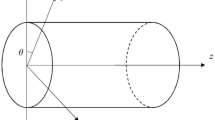Abstract
The static equilibrium of an electroelastic transversely isotropic space with a paraboloidal cavity under axisymmetric mechanical and electric loads is analyzed. Paraboloidal coordinates and special harmonic functions are used to obtain an exact solution. The distribution of stresses and electric-flux density over the surface of the cavity subject to internal pressure is analyzed as an example
Similar content being viewed by others
References
E. I. Grigolyuk, L. A. Fil’shtinskii, and Yu. D. Kovalev, “Tension of a piezoceramic layer weakened by through tunnel cavities,” Dokl. RAN, 385, No. 1, 61–63 (2002).
V. T. Grinchenko, A. F. Ulitko, and N. A. Shul’ga, Electroelasticity, Vol. 1 of the six-volume series Mechanics of Coupled Fields in Structural Members [in Russian], Naukova Dumka, Kiev (1989).
S. A. Kaloerov, A. I. Baeva, and Yu. A. Glushchenko, “Two-dimensional problem of electroelasticity for a multiply connected piezoelectric body with cavities and flat cracks,” Teor. Prikl. Mekh., 32, 64–79 (2001).
P. M. Morse and H. Feshbach, Methods of Theoretical Physics, Vol. 2, McGraw-Hill, New York (1953).
V. Z. Parton and B. A. Kudryavtsev, Electromagnetoelasticity of Piezoelectric and Electroconductive Bodies [in Russian], Nauka, Moscow (1988).
Yu. N. Podil’chuk, “On the stress-strain state of a transversally isotropic body with a paraboloidal inclusion,” Int. Appl. Mech., 34, No. 11, 1079–1085 (1998).
Yu. N. Podil’chuk, “Electroelastic equilibrium of transversally isotropic, piezoceramic media containing cavities, inclusions, and cracks,” Int. Appl. Mech., 34, No. 10, 1023–1034 (1998).
K. V. Solyanik-Krassa, Axisymmetric Problem of Elasticity [in Russian], Stroitekhizdat, Moscow (1987).
W. Chen and T. Shioya, “Fundamental solution for a penny-shaped crack in a piezoelectric medium,” J. Mech. Phys. Solids, 47, 1459–1475 (1999).
W. Q. Chen and C. W. Lim, “3D point force solution for a permeable penny-shaped crack embedded in an infinite transversely isotropic piezoelectric medium,” Int. J. Fract., 131, 231–246 (2005).
M. L. Dunn and M. Taya, “Electroelastic field concentrations in and around inhomogeneties in piezoelectric solids,” Trans. ASME, Ser. E, J. Appl. Mech., 61, 474–475 (1994).
S. A. Kaloerov, A. I. Baeva, and Yu. A. Glushchenko, “Two-dimensional electroelastic problem for a multiply connected piezoelectric body,” Int. Appl. Mech., 39, No. 1, 77–84 (2003).
I. F. Kirichok, “Flexural vibrations and heating of a circular bimorph piezoplate under electric excitation applied to nonuniformly electroded surfaces,” Int. Appl. Mech., 41, No. 9, 1037–1042 (2005).
V. S. Kirilyuk, “Stress state of an elastic orthotropic medium with an elliptic crack under tension and shear,” Int. Appl. Mech., 41, No. 4, 358–366 (2005).
V. S. Kirilyuk, “On the stress of a piezoceramic body with a flat crack under symmetric loads,” Int. Appl. Mech., 41, No. 11, 1263–1271 (2005).
Yu. N. Podil’chuk and I. G. Kovalenko, “Thermoelectroelastic state of a piezoceramic body with a spheroidal cavity in a uniform heat flow,” Int. Appl. Mech., 41, No. 11, 1254–1262 (2005).
F. Shang, M. Kuna, and M. Abendroth, “Finite element analysis of a three-dimensional crack problem in piezoelectric structures,” Eng. Fract. Mech., 70, 143–160 (2003).
H. Sosa and N. Khutoryansky, “New developments concerning piezoelectric materials with defects,” Int. J. Solids Struct., 33, No. 23, 3399–3414 (1996).
Z. K. Wang and S. H. Huang, “Stress intensification near an elliptical border,” Theor. Appl. Fract. Mech., 22, 229–237 (1995).
Z. K. Wang and B. L. Zheng, “The general solution of three-dimensional problems in piezoelectric media,” Int. J. Solids Struct., 32, 105–115 (1995).
J. Z. Zuo and G. C. Sih, “Energy density theory formulation and interpretation of cracking behavior for piezoelectric ceramics,” Theor. Appl. Fract. Mech., 34, 17–33 (2000).
Author information
Authors and Affiliations
Additional information
__________
Translated from Prikladnaya Mekhanika, Vol. 42, No. 9, pp. 59–69, September 2006.
Rights and permissions
About this article
Cite this article
Kirilyuk, V.S., Levchuk, O.I. Electroelastic stress state of a piezoceramic body with a paraboloidal cavity. Int Appl Mech 42, 1011–1020 (2006). https://doi.org/10.1007/s10778-006-0171-3
Received:
Issue Date:
DOI: https://doi.org/10.1007/s10778-006-0171-3



